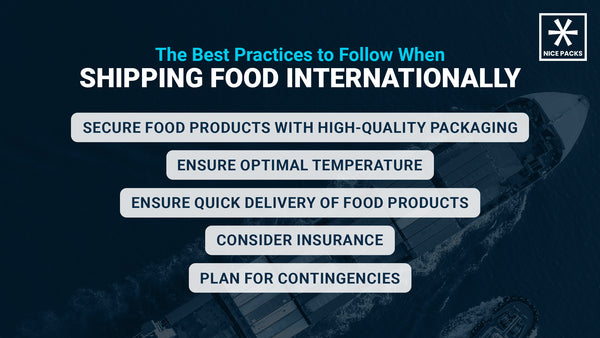Shipping food overseas is a complicated process that needs careful planning to keep the food safe and follow regulations. In this blog, we'll look at what affects shipping food internationally and provide a complete guide for businesses wanting to start shipping food internationally.
Is It Possible to Ship Perishable Food Items Internationally?

Credit: Envato Elements/ ramashkacom
Yes, you can send perishable foods internationally. But it needs careful planning and consideration of various factors. Even though it's tough, this opportunity is great for businesses that want to expand their market and reach new customers.
Factors to Consider When Shipping and Sending Food Abroad

Credit: Envato Elements/ innu_asha84
As mentioned above, there are several factors that businesses must take into account when shipping food internationally. These include:
1) Regulations and Compliance
Every country has its own rules for importing and exporting food. It's important to familiarize yourself with these rules and make sure your products follow them. This includes understanding the requirements for labeling, packaging, and documentation.
2) Transportation Methods
The method of transportation you choose will impact the safety and quality of your products. Air freight is the quickest method but also the most expensive. Sea freight is slower but cheaper. Your choice should depend on what food you're sending and how quickly it needs to get there.
3) Costs
Sending food globally can be expensive. It includes transportation expenses, packaging materials, regulatory compliance fees, and more. To ensure a successful international food shipping operation, it's important to thoroughly assess these costs and factor them into your pricing strategy in order to remain competitive and profitable.
4) Market Demand
When shipping food products internationally, it's important to understand the market demand of your target country. Conduct thorough market research to understand the expected demand for your product. This way, you can plan and make sure you have enough supplies to meet their needs.
The Best Practices to Follow When Shipping Food Internationally

Shipping food internationally can be tricky due to the number of factors that can go wrong. Since food is a temperature-sensitive item, here are some of the best practices to follow when sending food internationally:
1) Secure Food Products with High-Quality Packaging
To keep food fresh when shipping it overseas, proper packaging is key. Make sure to use high-quality, food-grade packaging materials, such as metal food tins, vacuum-sealed bags, and plastic wraps, to protect your products.
When packing, make sure that your food parcel does not mix food items, such as perishable raw and cooked foods. This can lead to cross-contamination and potential foodborne illness.
2) Ensure Optimal Temperature
Perishable food items are prone to spoilage due to their short shelf life and temperature sensitivity. Maintaining accurate temperature control is important to prevent this. Make sure to use insulated shipping containers and temperature monitoring techniques such as dry ice packs to keep food items at their required temperature throughout the entire shipping process.
3) Ensure Quick Delivery of Food Products
Quick delivery is important for preventing spoilage during international food shipments. Make sure to choose shipping methods that allow for quick delivery, such as express shipping, to ensure that your food products are delivered as quickly as possible.
4) Consider Insurance
Shipping food internationally can be risky. Therefore, it's important to consider insurance to protect yourself against potential losses due to spoilage. Insurance can cover a variety of risks, such as damage to food parcels during transportation, spoilage, and loss of products due to theft or other factors.
5) Plan for Contingencies
Despite careful planning, unexpected events can occur when a food item is shipped internationally. Make sure to plan for contingencies and to have processes in place to quickly respond to these unexpected events. This may include having backup plans for transportation, sourcing alternative suppliers, or having contingency plans for meeting customer demand.
Which Carriers Can You Ship Food Internationally With?
Here are some popular shipping carriers known for handling international food shipments:
1) FedEx
FedEx offers a range of international shipping services suitable for food products, including FedEx International Priority and FedEx International Economy. They provide temperature-controlled shipping options and specialized packaging solutions to keep perishable food items fresh during transit. They also offer customs clearance assistance and real-time tracking for international shipments, making it easier to monitor your food shipment's progress.
2) UPS
UPS provides international shipping services through UPS Worldwide Express and UPS Standard. Like FedEx, they offer temperature-controlled shipping options, including UPS Temperature True, to maintain the quality and freshness of perishable food items during transit. They also offer online tracking tools for monitoring shipments.
3) USPS (United States Postal Service)
USPS offers international shipping services for small to medium-sized food parcels through options like Priority Mail International and Priority Mail Express International. While they may not offer specialized temperature-controlled shipping, they provide reliable delivery services to many countries worldwide at competitive rates. They also customs forms and online tracking for international shipments, making it convenient to send food products to international destinations.
FAQs
Are There Any Food Items That Cannot Be Shipped Internationally?
Yes, certain food items may be restricted or prohibited from international shipping due to safety concerns, cultural sensitivities, or regulatory restrictions. Examples of such items include perishable foods that require strict temperature control, alcoholic beverages, certain types of cheeses, and products containing meat or dairy. It's important to check the regulations of both the origin and destination countries before attempting to ship any food items internationally.
Do I Need Special Permits or Licenses to Ship Food Internationally?
Yes, depending on the type of food products being shipped and the countries involved, you may need special permits, licenses, or certifications to legally export or import food internationally. These permits may include food safety certifications, import/export licenses, and documentation confirming compliance with food safety regulations.
How Can I Track the Status of My Food Shipment During International Transit?
Most shipping carriers offer online tracking services that allow you to monitor the whereabouts of your shipment in real time. Also, you can work with logistics providers that specialize in temperature-controlled shipping and offer advanced tracking solutions.
Can I Ship Fresh Fruits and Vegetables Internationally?
Depends. Certain countries may have restrictions due to concerns about pests, diseases, or agricultural contamination.
Summary
In conclusion, shipping food internationally is a great idea if you want to expand, but it also comes with its own set of challenges. By considering the factors outlined in this guide, you can successfully navigate the international food trade and expand your reach to new markets.
Are you looking to expand your food business internationally? Make sure your products arrive in top condition with Nice Packs! Our insulated shipping containers and dry ice packs provide the protection your food needs during transportation. Order now and take the first step toward expanding your business worldwide!


